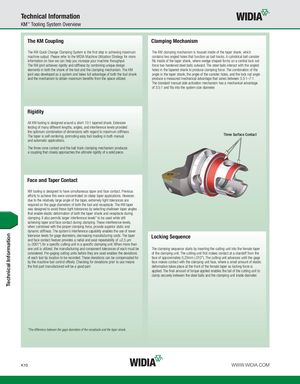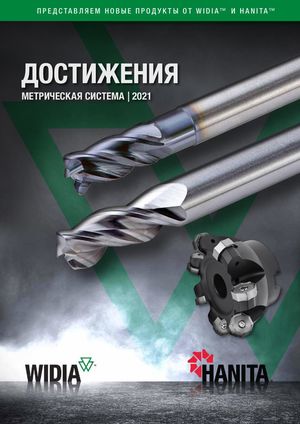Каталог Widia инструментальная оснастка - страница 1046
Навигация

Technical Information KM™ Tooling System Overview The KM Coupling Clamping Mechanism The KM Quick Change Clamping System is the first step in achieving maximum The KM clamping mechanism is housed inside of the taper shank, which machine output. Please refer to the WIDIA Machine Utilization Strategy for more contains two angled holes that function as ball tracks. A cylindrical ball canister information on how we can help you increase your machine throughput. fits inside of the taper shank, where wedge shaped forms on a central lock rod The KM joint achieves rigidity and stiffness by combining unique design force two hardened steel balls outward. The steel balls interact with the angled elements in both the shank of the tool and the clamping mechanism. The KM holes in the tapered shank to produce clamping force. The combination of the joint was developed as a system and takes full advantage of both the tool shank angle in the taper shank, the angle of the canister holes, and the lock rod angle and the mechanism to obtain maximum benefits from the space utilized. produce a measured mechanical advantage that varies between 3.5:1–7:1. The standard manual side activation mechanism has a mechanical advantage of 3.5:1 and fits into the system size diameter. Rigidity All KM tooling is designed around a short 10:1 tapered shank. Extensive testing of many different lengths, angles, and interference levels provided the optimum combination of dimensions with regard to maximum stiffness. The taper is self-centering, promoting easy tool loading in both manual Three Surface Contact and automatic applications. The three-zone contact and the ball track clamping mechanism produces a coupling that closely approaches the ultimate rigidity of a solid piece. Face and Taper Contact KM tooling is designed to have simultaneous taper and face contact. Previous efforts to achieve this were concentrated on steep taper applications. However, due to the relatively large angle of the taper, extremely tight tolerances are required on the gage diameters of both the tool and receptacle. The KM taper was designed to avoid these tight tolerances by selecting shallower taper angles that enable elastic deformation of both the taper shank and receptacle during clamping. It also permits larger interference levels* to be used while still achieving taper and face contact during clamping. These interference levels, when combined with the proper clamping force, provide superior static and dynamic stiffness. The system’s interference capability enables the use of lower tolerance levels for gage diameters, decreasing manufacturing costs. The taper Locking Sequence and face contact feature provides a radial and axial repeatability of ±2,5 μm (±.0001") for a specific cutting unit in a specific clamping unit. When more than one unit is utilized, the manufacturing and component tolerances of each must be The clamping sequence starts by inserting the cutting unit into the female taper considered. Pre-gaging cutting units before they are used enables the deviations of the clamping unit. The cutting unit first makes contact at a standoff from the of each tool tip location to be recorded. These deviations can be compensated for face of approximately 0,25mm (.010"). The cutting unit advances until the gage by the machine tool control offsets. Checking for deviations prior to use means face makes contact with the clamping unit face, where a small amount of elastic the first part manufactured will be a good part. deformation takes place at the front of the female taper as locking force is applied. The final amount of torque applied enables the tail of the cutting unit to clamp securely between the steel balls and the clamping unit inside diameter. *The difference between the gage diameters of the receptacle and the taper shank. K10 WWW.WIDIA.COM Technical Information
 Каталог Widia достижения 2021
Каталог Widia достижения 2021 Брошюра Widia решения для аэрокосмической промышленности
Брошюра Widia решения для аэрокосмической промышленности Брошюра Widia техническое руководство
Брошюра Widia техническое руководство Каталог Widia токарный инструмент 2020
Каталог Widia токарный инструмент 2020 Каталог Widia цельные концевые фрезы
Каталог Widia цельные концевые фрезы Каталог Widia техническое руководство по разверткам
Каталог Widia техническое руководство по разверткам